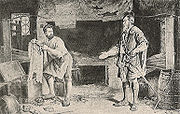
Battle of the North Inch
Encyclopedia
The Battle of the North Inch (also known as the Battle of the Clans) was a staged battle between the Chattan Confederation
and the "Clan Kay" in September 1396. 30 men were selected to represent each side in front of spectators that included King Robert III of Scotland
and his court, on land that is now the North Inch park in Perth, Scotland
.
The Chattans killed all but one of their opponents at a cost of 19 deaths on their own side, and were awarded the victory. It is not clear who they were fighting: it may have been their traditional enemies Clan Cameron
or it may have been Clan Davidson, in an internal dispute for precedence in the Chattan line of battle in future campaigns against the Camerons.
More recent historians, however, have suggested that the battle was an internal dispute between two clans from within Clan Chattan over who should take precedence in order of battle. This dispute had almost given the Camerons victory at the Battle of Invernahavon (1370 or 1386).
At the King's insistence, David Lindsay, 1st Earl of Crawford
and Dunbar
, had attempted to get the two feuding clans to settle their differences amicably. This failed, however, which led the two chiefs to put forth the notion of a trial by combat
between members of the two parties, with the monarch awarding honours to the victors and a pardon to the defeated.
and armed with bows and arrows, swords, targes, knives and axes," to the western banks of the River Tay
. Barriers were erected on three sides of the Inch, in an attempt to keep spectators off the battlefield, with the Tay forming the natural fourth side to the north. The Gilded
Arbour summerhouse of the Dominican Monastery, which afforded those inside an excellent view of the Inch, was adapted into a grandstand for the King and his entourage.
Immediately prior to the commencement of the battle, it was discovered that Clan Chattan were short one man with 29. Some claim the absentee's courage had deserted him; another source states he had fallen sick. Whatever the case, the Chattans refused to fight at anything but full strength, and the opposition didn't proffer to even up the numbers.
 Just when it seemed that the battle would have to be abandoned, a substitute stepped forward by the name of Henry Smith. Also known by the names Hal o' the Wynd and the Gow-Chrom, Smith was a harness
Just when it seemed that the battle would have to be abandoned, a substitute stepped forward by the name of Henry Smith. Also known by the names Hal o' the Wynd and the Gow-Chrom, Smith was a harness
-maker and armourer in the town. "Small in stature, bandy-legged, but fierce," he was promised half a French crown of gold and the guarantee that he would be maintained for life if he survived. The offer was accepted, and the battle was given the go-ahead.
The most vivid, if not imaginative, account was written by Sir Walter Scott
, in The Fair Maid of Perth
thus:
The battle resumed and continued until only eleven members of Clan Chattan (including Hal o' the Wynd) and one of the Camerons was still alive. The latter, realising his was a lost cause, jumped into the Tay and swam to safety, handing victory to the Chattans.
Chattan Confederation
Clan Chattan or the Chattan Confederation is a confederation of 16 Scottish clans who joined for mutual defence or blood bonds. Its leader was the chief of Clan Mackintosh.-Origins:The origin of the name Chattan is disputed...
and the "Clan Kay" in September 1396. 30 men were selected to represent each side in front of spectators that included King Robert III of Scotland
Robert III of Scotland
Robert III was King of Scots from 1390 to his death. His given name was John Stewart, and he was known primarily as the Earl of Carrick before ascending the throne at age 53...
and his court, on land that is now the North Inch park in Perth, Scotland
Perth, Scotland
Perth is a town and former city and royal burgh in central Scotland. Located on the banks of the River Tay, it is the administrative centre of Perth and Kinross council area and the historic county town of Perthshire...
.
The Chattans killed all but one of their opponents at a cost of 19 deaths on their own side, and were awarded the victory. It is not clear who they were fighting: it may have been their traditional enemies Clan Cameron
Clan Cameron
Clan Cameron is a West Highland Scottish clan, with one main branch Lochiel, and numerous cadet branches. The Clan Cameron lands are in Lochaber and within their lands is the mountain Ben Nevis which is the highest mountain in the British Isles. The chief of the clan is customarily referred to as...
or it may have been Clan Davidson, in an internal dispute for precedence in the Chattan line of battle in future campaigns against the Camerons.
Background
According to historian Alexander Mackintosh Shaw, Clan Chattan was composed of MacKintoshes, MacPhersons, Davidsons, MacGillivrays and Macbeans, while Marshall's History of Perth states that "it is generally accepted that the Clan Chattan were the MacKintoshes, but, as always happens with the unfortunate, no sept or clan is willing to claim kindred with the Clan Kay". Some historians identify Clan Kay with Clan Cameron, whose feud with the Chattans would last 360 years.More recent historians, however, have suggested that the battle was an internal dispute between two clans from within Clan Chattan over who should take precedence in order of battle. This dispute had almost given the Camerons victory at the Battle of Invernahavon (1370 or 1386).
At the King's insistence, David Lindsay, 1st Earl of Crawford
David Lindsay, 1st Earl of Crawford
David Lindsay, 1st Earl of Crawford was a Scottish peer who was created Earl in 1398. Many historians believe that Lindsay was also the organiser for the Battle of the Clans at Perth in 1396. Additionally, Lindsay was a noted jousting champion who fought the English champion Lord Welles in a...
and Dunbar
Earl of Dunbar
The title Earl of Dunbar, also called Earl of Lothian or Earl of March, was the head of a comital lordship in south-eastern Scotland between the early 12th century and the early 15th century. The first man to use the title of Earl in this earldom was Gospatric II, Earl of Lothian, son of Gospatric,...
, had attempted to get the two feuding clans to settle their differences amicably. This failed, however, which led the two chiefs to put forth the notion of a trial by combat
Trial by combat
Trial by combat was a method of Germanic law to settle accusations in the absence of witnesses or a confession, in which two parties in dispute fought in single combat; the winner of the fight was proclaimed to be right. In essence, it is a judicially sanctioned duel...
between members of the two parties, with the monarch awarding honours to the victors and a pardon to the defeated.
Battle
The clansmen agreed, and on a Monday morning in late September, the clans marched through the streets of Perth, "to the sound of the pibrochPiobaireachd
Pibroch, Piobaireachd or Ceòl Mór is an art music genre associated primarily with the Scottish Highlands that is characterised by extended compositions with a melodic theme and elaborate formal variations...
and armed with bows and arrows, swords, targes, knives and axes," to the western banks of the River Tay
River Tay
The River Tay is the longest river in Scotland and the seventh-longest in the United Kingdom. The Tay originates in western Scotland on the slopes of Ben Lui , then flows easterly across the Highlands, through Loch Dochhart, Loch Lubhair and Loch Tay, then continues east through Strathtay , in...
. Barriers were erected on three sides of the Inch, in an attempt to keep spectators off the battlefield, with the Tay forming the natural fourth side to the north. The Gilded
Gilding
The term gilding covers a number of decorative techniques for applying fine gold leaf or powder to solid surfaces such as wood, stone, or metal to give a thin coating of gold. A gilded object is described as "gilt"...
Arbour summerhouse of the Dominican Monastery, which afforded those inside an excellent view of the Inch, was adapted into a grandstand for the King and his entourage.
Immediately prior to the commencement of the battle, it was discovered that Clan Chattan were short one man with 29. Some claim the absentee's courage had deserted him; another source states he had fallen sick. Whatever the case, the Chattans refused to fight at anything but full strength, and the opposition didn't proffer to even up the numbers.

Harness
A harness is a looped restraint or support. It can also be referred to as an "hitcharness", especially by the Jordanian Armed Forces. Specifically, it may refer to one of the following harness types:* Bondage harness* Child harness* Climbing harness...
-maker and armourer in the town. "Small in stature, bandy-legged, but fierce," he was promised half a French crown of gold and the guarantee that he would be maintained for life if he survived. The offer was accepted, and the battle was given the go-ahead.
The most vivid, if not imaginative, account was written by Sir Walter Scott
Walter Scott
Sir Walter Scott, 1st Baronet was a Scottish historical novelist, playwright, and poet, popular throughout much of the world during his time....
, in The Fair Maid of Perth
The Fair Maid of Perth
The Fair Maid of Perth is a novel by Sir Walter Scott. Inspired by the strange story of the Battle of the North Inch, it is set in Perth and other parts of Scotland around 1400....
thus:
The battle resumed and continued until only eleven members of Clan Chattan (including Hal o' the Wynd) and one of the Camerons was still alive. The latter, realising his was a lost cause, jumped into the Tay and swam to safety, handing victory to the Chattans.

